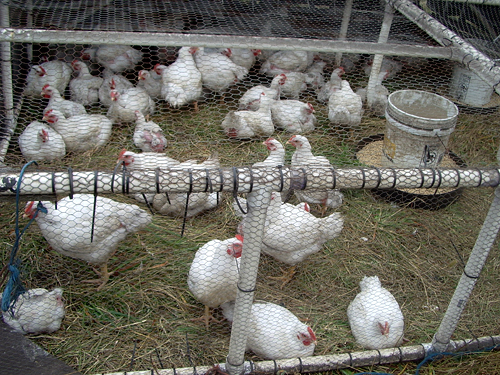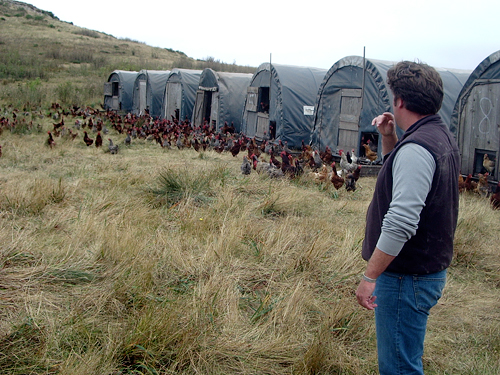Introducing himself, owner Dave Evans launched into a freewheeling oral history of the land where we're standing. It's a topic he knows well: his family has been working this land as dairy and cattle farmers for four generations, since his great-grandfather, once a dairy farmer in Switzerland, moved to California and began raising cattle in West Marin.
Damp, chilly, and fogbound much of the year, the rolling hills of the Point Reyes peninsula weren't worth much as farmland. But they were perfect for growing lush, green grass that stayed green for a lot longer than in the hot inland valleys. Cows raised on Point Reyes grass produced particularly good milk--and thanks to steamships that chugged from Drakes' Estero and Tomales Bay down into San Francisco (later replaced by refrigerated trucks), butter stamped "PR" quickly developed a reputation for superior freshness and quality.
Evans' family, like many others on the area's historic lettered system of dairy farms, continued as a dairy farmers until the mid-70s. Then, as milk prices dropped and the dairy industry began to consolidate, Evans' parents switched to beef cattle. Evans was born in 1972, on the original "H" ranch owned by his grandfather.
Now, the land is owned by the National Park Service, as part of the Point Reyes National Seashore established by President Kennedy in 1962. As an acknowledgment of the area's living history, a special pastoral zone was created as part of the federal mandate, allowing descendants of the area's original ranching families to continue to raise livestock. Evans and his relatives lease their land from the Park Service, abiding by an often-complex set of park rules.

The end result? A herd of cows living on perhaps the most scenic pastureland in California, munching their way year-round through an assortment of native and perennial grasses and plants. They're followed by two different sets of chicken trailers: high, tarp-covered nesting boxes for the layers, and low, fenced-in hutches for the meat birds.

The layers--a mixture of Barred Rocks, Ameraucanas, Brown and Gold Sexlinks, and Rhode Island Reds--are rovers. Watched over by one of the farm's brawny, blase guard dogs, the chickens wander freely in front of their mobile homes, gossiping, pecking, scratching, and wallowing, like a feathered bunch of middle schoolers during recess. The eggs they lay are collected daily.

At dusk, the chickens retreat into the houses to roost, and the doors are locked against predators. The next day, the houses, perched on heavy wooden runners, are hooked up to a truck and moved to a fresh section of pasture.

The meat birds, by contrast, don't have as much interest in the outside world. They prefer to clump together, eating a naturally omnivorous diet of grass, bugs, and grain and yes, fattening up remarkably fast. In just a few months, the birds go from downy yellow chicks peeping under the heat lamps of the brood houses to fully-grown white-feathered birds, ready for the table.
Running a successful livestock operation on the land where he was born and bred is a particular source of satisfaction for Evans. Graduating from Cal Poly with an agricultural business degree, he was already convinced that he knew the best place to work, and it wasn't going to be one of the huge CAFOs in Iowa that came recruiting at the school's job fairs. Instead, he went back to his family's land, working on his father's ranch, then branching out into a fencing company of his own.
Marin Sun started with a few dozen cows grazing on leased property in Nicasio. His initial goal? To market maybe 5 animals a year, exclusively grass-fed. Then Michael Pollan's New York Times Magazine article "Power Steer" happened, and millions of people were suddenly shocked by the brutal realities of life and death in the feedlot. "We'd bought a $5 ad on Eatwild, the only marketing we were doing at the time. Pollan's article told people to go to Eatwild to find grass-fed beef, and that day our phone rang off the hook." The ensuing years, Evans admits, were a blur as the company and the cows grew.
Now, some 11 years later, Evans is raising his cattle and chickens back on the land where he grew up. Marin Sun cuts, ages, packages, and distributes all its own meat around the Bay Area, to restaurants, grocery stores, two of its own butcher shops (the company recently took over the butcher shop in the Rockridge Market Hall), and a 200+member meat CSA. Everything but the slaughtering (done at a facility in Petaluma) is done in-house, either in space rented at a warehouse along the waterfront in San Francisco or in a warren of small, white-walled rooms hidden behind the butcher shop and cafe in Point Reyes Station. Here, four men stand at a waist-high counter, breaking down primal cuts into retail-ready parts.
Walking into the refrigerated storage room, I was struck not just by the visceral reality of the meat--shelves labeled (and stocked) with goat heads, lamb legs, beef tongues--but by the clean, healthy look and smell of it all. Yes, the room smelled like meat, but it was a pleasing smell. These were animals that had had a healthy life, and it showed. You may not agree with raising or eating animals for food, but if it's going to be done, it should be done right, and here, it is.
Not all of Marin Sun's meat comes from Evans' own ranch. The realities of pasture-raising means that his own animals reach their finished weight only during a particular three-month window each year. "No restaurant, no supermarket wants to deal with a producer who only has product 3 months out of the year," noted Evans.
The answer? Establishing a network of co-producers, ranchers working in a variety of local micro-climates who would raise their livestock on pasture according to Marin Sun protocols. The goats, for example, are raised by Evans' sister, so close by that his own guard dogs often trot over to do a little goat herding, just for fun. Other ranchers raise lamb and sheep, pigs, and cows. More meat raised by Marin Sun protocols means more humane ranching, and more ranchers able to make a living working sustainably.
All well and good, of course, but the proof rests with the plate. Just a few months ago, Marin Sun started serving lunches again at their butcher shop in Point Reyes Station. The menu is brief: three burgers, a couple of salads, and fries, plus beer, wine, and Blue Bottle coffee. You order off a chalkboard at the counter, pay, and then sit at one of the tables covered with (what else?) brown butcher paper.

The day I visited, the options were a lamb burger topped with Pt Reyes Blue cheese, a beef burger with raw-milk cheddar and house-smoked bacon, and a goat burger topped with caramelized onions and goat cheese. We tried the lamb and the goat, and they were, quite simply, fantastic: juicy and pink inside, full of rich and meaty flavor and served with a fat half-pickle and a fluff of mixed greens. French fries, crisped in pork fat, are for serious meat-lovers only; while the texture is great (crisp outside, fluffed inside), the pork fat makes these some seriously heavyweight fries.
Perusing the meat cases after lunch, I picked out a plump half chicken breast. I felt that now I could read the life story of the chicken in my hand, from its arrival at the farm through its time in the brood houses, its life out in the pastures and then onto the table. I took it home, roasting it simply with lemon and garlic to juicy, brown-skinned perfection and a truly local taste.





